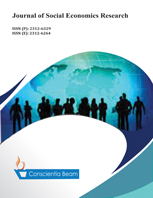The Role of Internal Migration in Poverty Reduction of Vietnam
DOI:
https://doi.org/10.18488/35.v9i1.3007Abstract
By applying a simultaneous equation model to provincial-level data in Vietnam from 2010 to 2019, this study estimates the impact of internal migration on poverty reduction through changes in human capital and transformation in the labor structure. The results demonstrate that internal migration contributes to poverty reduction in the considered areas through increasing human capital and promoting labor mobility from the agricultural sector to its non-agricultural counterpart. This finding implies that it is necessary to create favorable conditions for learning and improving labor skills for migrants. The study also indicates further evidence of the relationship between the geography element and poverty. The Northern Uplands region in Vietnam is experiencing unfavorable conditions that lead to high poverty rates and limited internal migration. Therefore, increasing the mobility of the poor in the region may need further attention in addition to existing poverty reduction policies.

